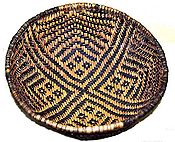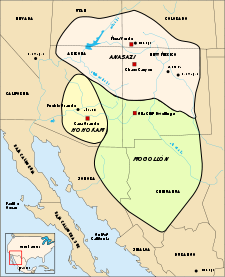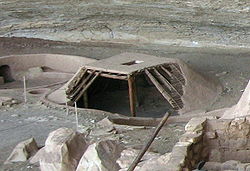
Basketmaker III Era
Encyclopedia


Pit-house
A pit-house is a dwelling dug into the ground which may also be layered with stone.These structures may be used as places to tell stories, dance, sing, celebrate, and store food. In archaeology, pit-houses are also termed sunken featured buildings and are found in numerous cultures around the world...
dwellings. Hunting was easier with the adoption of the bow and arrow.
Architecture

Pit-house
A pit-house is a dwelling dug into the ground which may also be layered with stone.These structures may be used as places to tell stories, dance, sing, celebrate, and store food. In archaeology, pit-houses are also termed sunken featured buildings and are found in numerous cultures around the world...
s, but the architecture changed. Now the houses were larger, included division on the space into sections, a large central hearth, addition of vestibules, and slabs of stone were used to line the walls.
Most pit-houses were built out in the open on tops of mesa
Mesa
A mesa or table mountain is an elevated area of land with a flat top and sides that are usually steep cliffs. It takes its name from its characteristic table-top shape....
s. Pit-houses were built in a hole several feet deep between 8 to 20 ft (2.4 to 6.1 m) in diameter. A log frame was built to support side walls and a roof that were covered with woven reeds, grass and, lastly, mud for weatherproofing. In the center of a roof was an opening used for ventilation and an entrance to the dwelling. Some pit-houses had an attached storage room.
Communities
- Mesa VerdeMesa Verde National ParkMesa Verde National Park is a U.S. National Park and UNESCO World Heritage Site located in Montezuma County, Colorado, United States. It was created in 1906 to protect some of the best-preserved cliff dwellings in the world...
. Small groupings of pit houses were built on the top of mesas.
- Chaco CanyonChaco Culture National Historical ParkChaco Culture National Historical Park is a United States National Historical Park hosting the densest and most exceptional concentration of pueblos in the American Southwest. The park is located in northwestern New Mexico, between Albuquerque and Farmington, in a remote canyon cut by the Chaco Wash...
. From about AD 450-700 more than 200 Basketmaker sites sat on Chaco Canyon mesas, ridges, and the canyon floor. The sites had clusters of 1-20 pit-houses. One of its villages, Shabik'eschee, was the type siteType siteIn archaeology a type site is a site that is considered the model of a particular archaeological culture...
for this period. Although most village sites were relatively small during this period, Shabik'eschee (about AD 550 - 700) contained 18 pit-houses for an estimated 77 people, more than 50 storage pits, and a large pit-house used for celebration and rituals. This compares to an average settlement for 5 to 15 people. The large pit-house was likely a "great" kivaKivaA kiva is a room used by modern Puebloans for religious rituals, many of them associated with the kachina belief system. Among the modern Hopi and most other Pueblo peoples, kivas are square-walled and underground, and are used for spiritual ceremonies....
. Based on the number of extra pit-houses for storage, it is possible that the village was visited from nearby settlers.
- Pleasant View, Colorado. There may have been pressure within the Basketmaker III communities to ensure their safety. StockadeStockadeA stockade is an enclosure of palisades and tall walls made of logs placed side by side vertically with the tops sharpened to provide security.-Stockade as a security fence:...
s encircled pit-housePit-houseA pit-house is a dwelling dug into the ground which may also be layered with stone.These structures may be used as places to tell stories, dance, sing, celebrate, and store food. In archaeology, pit-houses are also termed sunken featured buildings and are found in numerous cultures around the world...
s in at least 11 sites within a 10 miles of Pleasant View, ColoradoPleasant View, ColoradoPleasant View is an unincorporated town and a U.S. Post Office located in Montezuma County, Colorado, United States. The Pleasant View Post Office has the ZIP Code 81331....
. The settlements (dated from AD 600-700) could have been fenced to ensure safety of children or contain domesticated dogs and turkeys. It is considered is more likely that they were built as a defensive measure, based upon extensive collections of burnt artifactArtifact (archaeology)An artifact or artefact is "something made or given shape by man, such as a tool or a work of art, esp an object of archaeological interest"...
s from the sites. A theory is that other local people may have waged war having felt displaced by the number of new Basketmaker III settlements in the area.
Culture and religion
During this period the social and political structure was likely informal, with heads of households making decisions by consensus.Petroglyphs of people and animals were made in the Petrified Forest National Park
Petrified Forest National Park
Petrified Forest National Park is a United States national park in Navajo and Apache counties in northeastern Arizona. The park's headquarters are about east of Holbrook along Interstate 40 , which parallels a railroad line, the Puerco River, and historic U.S. Route 66, all crossing the park...
during this period.
Agriculture
Beans, squash and maize were cultivated in this period. The farm also include the raising of turkeys, both for feathers and a source of food. Food was kept in storage cists, below ground pits that were lined and covered with stone. People also hunted, trapped and gathered wild nuts, plants and fruit.Pottery
In the Basketmaker III era pottery was introduced which reduced the number of baskets that they made and eliminated the creation of woven bags. Simple, gray pottery was a more effective vessel for cooking, storage and carrying water. The people in the area of the Petrified Forest National ParkPetrified Forest National Park
Petrified Forest National Park is a United States national park in Navajo and Apache counties in northeastern Arizona. The park's headquarters are about east of Holbrook along Interstate 40 , which parallels a railroad line, the Puerco River, and historic U.S. Route 66, all crossing the park...
made Adamana Brown pottery, considered the earliest pottery on the Colorado Plateau
Colorado Plateau
The Colorado Plateau, also called the Colorado Plateau Province, is a physiographic region of the Intermontane Plateaus, roughly centered on the Four Corners region of the southwestern United States. The province covers an area of 337,000 km2 within western Colorado, northwestern New Mexico,...
.
Material goods
The Basketmaker people's skill at making baskets and weaving improves during this period. Part of their output includes bags, baskets, sandals, sashes and other woven items. PitchPitch (resin)
Pitch is the name for any of a number of viscoelastic, solid polymers. Pitch can be made from petroleum products or plants. Petroleum-derived pitch is also called bitumen. Pitch produced from plants is also known as resin. Products made from plant resin are also known as rosin.Pitch was...
-lined baskets held water where food was cooked by placing hot stones in a water-filled basket. Bows and arrows made hunting easier and thus the acquisition of hides for clothing. Spears and darts continued to be used, but with less regularity. Turkey feathers were woven into blankets and robes. Babies were carried in soft, non-deforming cradle boards.
Other common material goods of the time were:
- Yucca woven sandals and rope
- Stone axes, knives and other tools used to pound, scrape and cut.
- Stone metateMetateA metate is a mortar, a ground stone tool used for processing grain and seeds. In traditional Mesoamerican culture, metates were typically used by women who would grind calcified maize and other organic materials during food preparation...
s and manos to grind corn - Bones stitching awlStitching awlA stitching awl is a simple tool with which holes can be punctured in a variety of materials, or existing holes can be enlarged. It is also used for sewing heavy materials, such as leather or canvas. It is a thin, tapered metal shaft, coming to a sharp point, either straight or slightly bent....
s and scrapers - Nets and snares to trap small game
- Sticks for digging to plant seeds
- Cradleboards made from yucca, twigs and rabbit fur
Cultural groups and periods
The cultural groups of this period include:- Anasazi - southern UtahUtahUtah is a state in the Western United States. It was the 45th state to join the Union, on January 4, 1896. Approximately 80% of Utah's 2,763,885 people live along the Wasatch Front, centering on Salt Lake City. This leaves vast expanses of the state nearly uninhabited, making the population the...
, southern ColoradoColoradoColorado is a U.S. state that encompasses much of the Rocky Mountains as well as the northeastern portion of the Colorado Plateau and the western edge of the Great Plains...
, northern ArizonaArizonaArizona ; is a state located in the southwestern region of the United States. It is also part of the western United States and the mountain west. The capital and largest city is Phoenix...
and northern and central New MexicoNew MexicoNew Mexico is a state located in the southwest and western regions of the United States. New Mexico is also usually considered one of the Mountain States. With a population density of 16 per square mile, New Mexico is the sixth-most sparsely inhabited U.S...
. - HohokamHohokamHohokam is one of the four major prehistoric archaeological Oasisamerica traditions of what is now the American Southwest. Many local residents put the accent on the first syllable . Variant spellings in current, official usage include Hobokam, Huhugam and Huhukam...
- southern Arizona. - Mogollon - southeastern Arizona, southern New Mexico and northern MexicoMexicoThe United Mexican States , commonly known as Mexico , is a federal constitutional republic in North America. It is bordered on the north by the United States; on the south and west by the Pacific Ocean; on the southeast by Guatemala, Belize, and the Caribbean Sea; and on the east by the Gulf of...
. - PatayanPatayanPatayan is a term used by archaeologists to describe prehistoric and historic Native American cultures who inhabited parts of modern day Arizona, west to Lake Cahuilla in California, and in Baja California, between 700–1550 CE...
- western Arizona, California and Baja California.
Notable Basketmaker III sites
- Chaco Culture National Historical ParkChaco Culture National Historical ParkChaco Culture National Historical Park is a United States National Historical Park hosting the densest and most exceptional concentration of pueblos in the American Southwest. The park is located in northwestern New Mexico, between Albuquerque and Farmington, in a remote canyon cut by the Chaco Wash...
- New Mexico - Durango Rock Shelters Archeology SiteDurango Rock Shelters Archeology SiteDurango Rock Shelters Archeology Site is also known as the Fall Creek Rock Shelters Site. An Ancient Pueblo People archaeological site, it is located in Durango in La Plata County, Colorado. People from the Late Basketmaker II and Basketmaker III Eras inhabited the site between AD 0 and AD...
- Colorado (Basketmaker II type siteType siteIn archaeology a type site is a site that is considered the model of a particular archaeological culture...
) - Grand Staircase-Escalante National MonumentGrand Staircase-Escalante National MonumentThe Grand Staircase-Escalante National Monument contains 1.9 million acres of land in southern Utah, the United States. There are three main regions: the Grand Staircase, the Kaiparowits Plateau, and the Canyons of the Escalante. President Bill Clinton designated the area as a U.S. National...
- Utah - Grand Canyon areaHistory of the Grand Canyon areaThe known history of the Grand Canyon area stretches back 10,500 years, when the first evidence of human presence in the area is found. Native Americans have inhabited the Grand Canyon and the area now covered by Grand Canyon National Park for at least the last 4,000 of those years...
- Arizona - Hovenweep National MonumentHovenweep National MonumentHovenweep National Monument is located on land in southwestern Colorado and southeastern Utah, located between Cortez, Colorado and Blanding, Utah on the Cajon Mesa of the Great Sage Plain...
- Colorado - Kanab CreekKanab CreekKanab Creek is one of the many tributaries of the Grand Canyon. It begins in Kane County, Utah, just south of the watershed to the Great Basin and flows south to the Colorado River. It passes Kanab, Utah, crossing the border to Arizona near Fredonia...
area - Utah and Arizona - Mesa Verde National ParkMesa Verde National ParkMesa Verde National Park is a U.S. National Park and UNESCO World Heritage Site located in Montezuma County, Colorado, United States. It was created in 1906 to protect some of the best-preserved cliff dwellings in the world...
- Colorado - Petrified Forest National ParkPetrified Forest National ParkPetrified Forest National Park is a United States national park in Navajo and Apache counties in northeastern Arizona. The park's headquarters are about east of Holbrook along Interstate 40 , which parallels a railroad line, the Puerco River, and historic U.S. Route 66, all crossing the park...
- Arizona - Virgin AnasaziVirgin AnasaziThe Virgin Anasazi were the westernmost Ancestral Puebloan group in the American Southwest. They occupied the area in and around the Virgin River and Muddy Rivers, the western Colorado Plateau, the Moapa Valley and were bordered to the south by the Colorado River. They occupied areas in present day...
- Colorado PlateauColorado PlateauThe Colorado Plateau, also called the Colorado Plateau Province, is a physiographic region of the Intermontane Plateaus, roughly centered on the Four Corners region of the southwestern United States. The province covers an area of 337,000 km2 within western Colorado, northwestern New Mexico,...
of Nevada, Utah and Arizona

